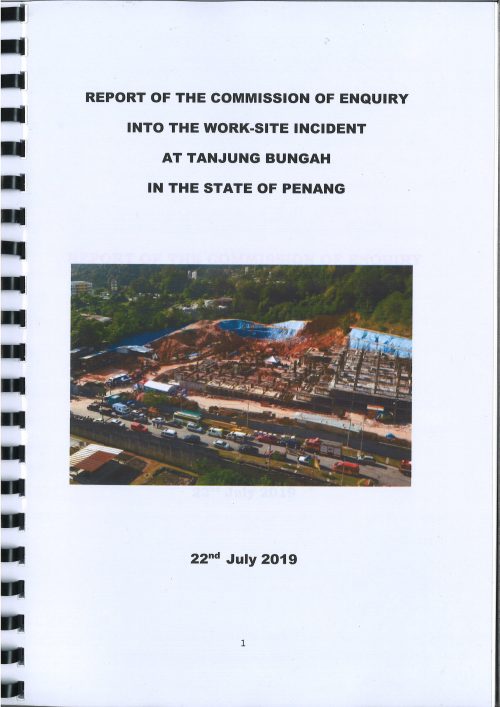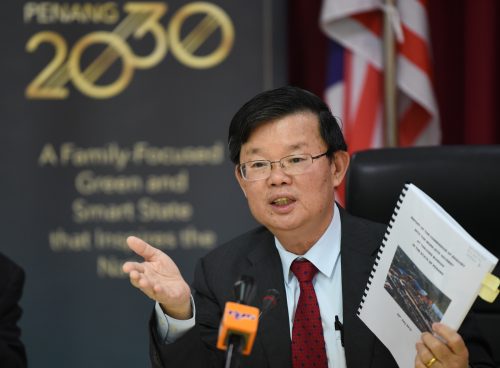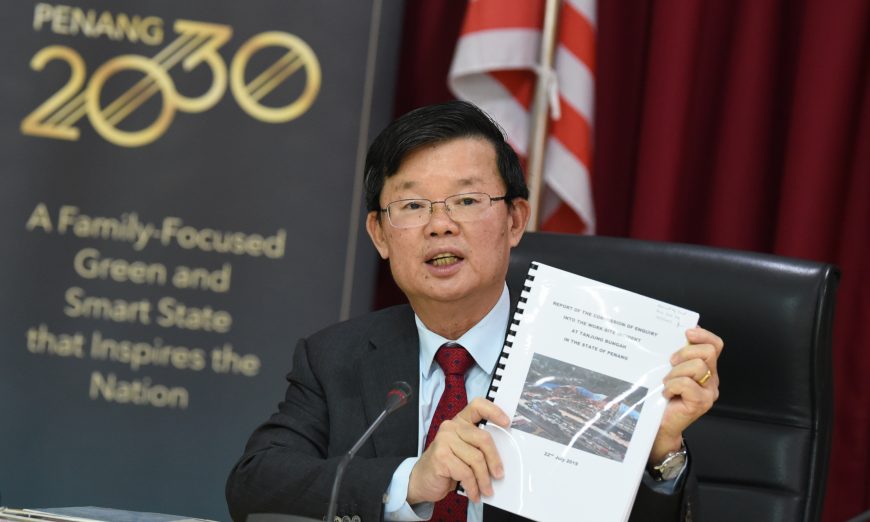THE State Commission of Inquiry (SCI) has found that the Tanjung Bungah landslide on Oct 21, 2017 was a man-made tragedy in its probe. The report also stated that the incident was entirely preventable.
The 116-page report, which was made available to the media during a press conference today, recommended that action to be taken against two engineers for negligence.
Chief Minister Chow Kon Yeow said that the Commission had conducted its hearings in public over 26 days and heard testimonies from 28 witnesses. The SCI also considered voluminous documents, reports, photographs and drawings, as well as opinions from six expert witnesses.
“It is, among others, the finding of the Commission that the slope-failure on Oct 21, 2017, was caused by a series of successive acts and omissions.
“The report dated July 22 this year, which has been submitted to the Penang Governor, provides further analysis on the background facts, excerpts of testimonies recorded during the hearings and findings on liability against several parties.
“The report also contained nine recommendations which serve as the Commission’s hope that lessons learned from this unfortunate episode will not be in vain,” he told a press conference at his office today.
Chow recorded the state’s deepest condolences to the family members of the 11 individuals who perished in the tragedy.
“May the findings in the report provide some form of closure for the victims’ families and loved ones,” he said.

According to the report, the landslide on that fateful morning did not simply develop overnight. It was a disaster which had been waiting to happen, for a period of time. It was also stated that the landslide occurred because the disturbing forces had exceeded the soil resistance.
The cumulative effect of a fatal combination of the series of 15 negligent acts and omissions resulted in the loss of 11 lives, the report stated.
The Commission concluded that the project consultant engineer, from the civil and structural engineering consultants (C&S Consultants), was the person primarily responsible for having caused the disaster. The C&S Consultants were also the superintendent officer (SO) for the earthworks.
It also found that the designer-engineer for the piling and pile caps works was contributory negligent in relation to the slope-failure.
The building contractor had been negligent in one aspect – ignoring its own safety officer’s warning and advice that the slope was unsafe, and in allowing its workers to work near the toe of the slope at the time of its collapse.
The SCI also found that, based on available evidence, the Department of Occupational Safety and Health (DOSH) was negligent in failing to take adequate steps to ascertain the extent of the danger posed by the unsafe slope. According to the report, DOSH had failed to promptly issue a Prohibition Notice pursuant to Section 48 of the Occupational Safety and Health Act 1994 after its visit to the site on Aug 18, 2017. Instead, the department issued an Improvement Notice.
It was also highlighted that no resident engineer had been stationed on-site by the C&S Consultants to undertake the overall supervision of the earthworks and the permanent works, since the commencement of works until the day of the tragedy (about 26 months). It was also noted that for the first 12 months of works, the C&S Consultants did not have any clerk of works on-site.
The report also mentioned that there were five nature’s warnings prior to the disaster which include a minor landslip on Aug 8, 2016; water purging from a drilled hole at one of the soil nails which was being installed at that time on April 27, 2017; the second minor landslip on May 5, 2017; the gunite surface covering part of the slope cracked on June 19, 2017; and the third landslip on July 11, 2017.
The Commission also found that the safety officer of the building contractor (who was not an engineer) tried to warn his superiors, as he felt that it was not safe for workers to work at or near the slope. According to the report, his advice was not taken seriously and that the project consultant engineer decided that permanent works could continue, near the toe of the partially-failed slope.
“If the safety officer’s advice had been followed, 11 lives would have been saved,” the report stated.
The SCI report also said that the safety officer wrote a memo dated Aug 1, 2017, to the earthworks contractor and piling contractor; and copied to the developer and to DOSH warning them of the dangers.
“Probably as a result of the memo, officers from DOSH visited the site on Aug 18, 2017. The department issued an Improvement Notice to the building contractor on the same day,” the report mentioned.
The SCI found that the project consultant engineer was the primary person responsible for the slope-failure by reason of his series of negligent acts and omissions detailed in the report.
The Commission was also of the view that the project consultant engineer’s gross negligence, which had caused the death of the 11 people, warrants a criminal investigation under Section 304A of the Penal Code.
The operator of the nearby quarry, the sub-contractors in their respective spheres, the firm of architects, the developer, and the Penang Island City Council (MBPP) were found not to be responsible for the slope-failure.
The SCI recommended that the Board of Engineers Malaysia (BEM) initiates or commences disciplinary action against the project consultant engineer, to look into all aspects of his gross negligence, misconduct and/or unprofessional conduct. The Commission also recommended that a criminal investigation be conducted by the police (on the direction of the Attorney General, if necessary), into the project consultant engineer’s gross negligence which had caused the loss of 11 lives; to determine whether he ought to be prosecuted under Section 304A of the Penal Code.
The Commission also recommended the BEM to initiate or commence disciplinary action against the designer-engineer.
Other recommendations include for MBPP to immediately draw up and enforce a policy that no development project should be allowed to commence any work (including earthworks), until and unless a qualified resident engineer(s) has been employed and stationed at the site to supervise construction works. Projects of larger sizes would require a team of resident engineers.
DOSH was encouraged to consider implementing a policy of surprise checks at construction sites (without the need of a complaint), if it does not already do so regularly.
The Commission also recommended that the ‘Safety Guideline for Hillsite Development 2012’ be amended, to render it applicable to any and all slopes (whether permanent or otherwise, natural or man-made (and whether existing or only to be formed later during construction), which has (or is intended to have) any flight above the gradient of 25 degrees.
It also recommended that MBPP and DOSH review their current criteria for the issuance of stop-work orders to better address situations of suspected danger of risk to life or property in the future.
Chow said that the state would send the SCI report to the respective agencies.

“The secretary of the Commission had already given us the report and a list (of parties) for us to distribute to. The report will be distributed as per the recommendation of the secretary of the Commission,” Chow said.
Copies of the report are available for sale at RM50 per copy from Sept 3 to 30.
The report can be purchased via cash payment and collected at Level 3, Komtar.
For further details, call 04-650 5480.
Story by Christopher Tan
Pix by Darwina Mohd Daud
Video by Noor Siti Nabilah Noorazis

